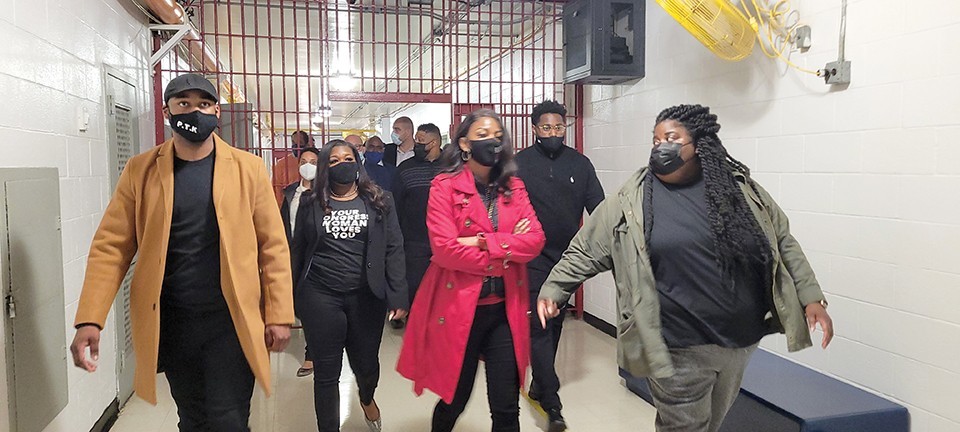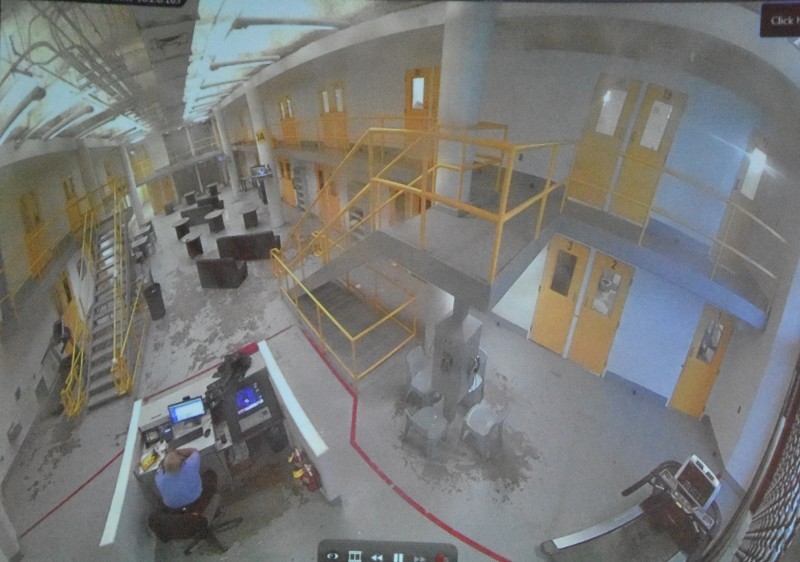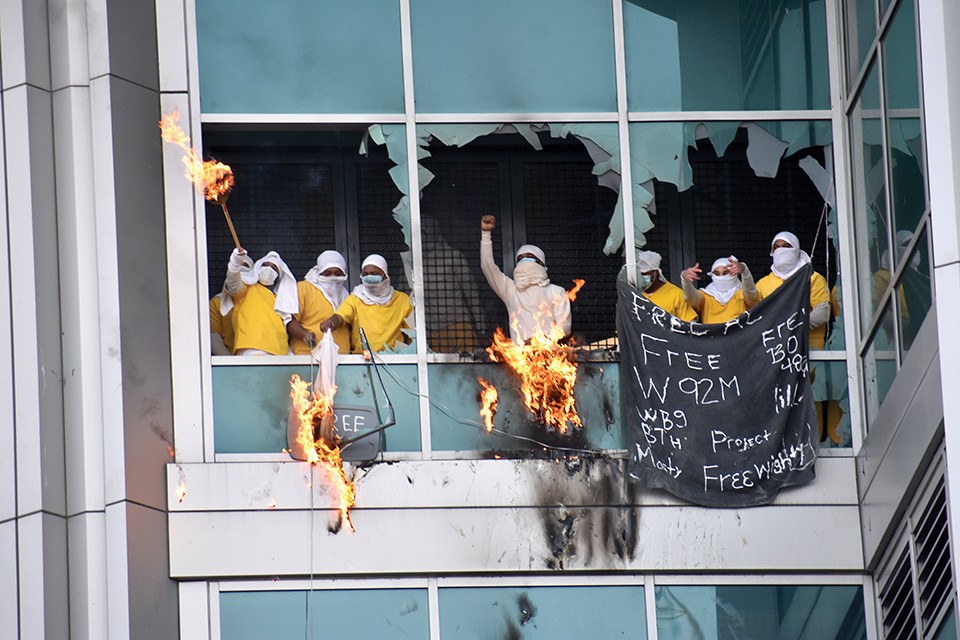At the end of 2020, the City of St. Louis placed an unusually large order for pepper spray to use in its two jails.
The city's public safety department wanted 30 small flip-top canisters, 30 large ones with pistol grips and 30 of what the Fenton-based manufacturer SABRE calls its Cell Buster, a 16-ounce canister outfitted with a hose that guards can use to slip under doors and fill an entire cell with a cloud of stinging chemical irritant in a matter of seconds.
It was the third purchase order of the year, which was in itself a marked increase in frequency from recent years, and it was the largest yet. The total price was $3,347, according to a December 2020 invoice reviewed by the Riverfront Times. For context, that's about 14 percent more than the previous two orders combined.
Life inside the jails had been growing increasingly tense at the time. Thanks to an activist-led effort, hundreds of people had been sent home from the jails in the past year to create a little more space and hopefully minimize the spread of COVID-19, but for those left behind, the situation had deteriorated. There were reports of virus outbreaks and healthy detainees trapped near sick ones. In addition, closed courts meant endless stays for defendants, who even in normal times averaged nearly a year inside before cases were decided. And new safety protocols had cut off family visits and limited detainees' freedoms even further.
No one was happy. A number of the problems could be attributed to the ongoing threat of the virus and a corrections department on its heels, but according to those riding out the pandemic inside, the problems went beyond logistical headaches to good old-fashioned abuse at the hands of guards.
In hotlines set up to take in complaints, nonprofit organizations the Bail Project and ArchCity Defenders fielded calls from detainees and their families about aggressive, retaliatory tactics. ArchCity and three other entities later detailed multiple allegations against the city and jail staff, including accusations that guards often punished detainees by shutting off water to units — and using egregious amounts of pepper spray.
For the general public, just how bad it had become at city jails first became obvious through two revolts in which detainees seized control of entire units, busted out exterior windows and shouted complaints to the outside world.
The sight of men in jail jumpsuits standing in the smoke-filled frames of broken windows, holding homemade torches aloft in the heart of St. Louis, was an embarrassing scene for city leaders, one that was replayed in national and international news coverage. Then-Mayor Lyda Krewson and Director of Public Safety Jimmie Edwards promised to address issues at the jails. A task force created to investigate problems was announced at a news conference as part of the response. Left unsaid, however, was that the city was quietly loading up on pepper spray.
Another SABRE invoice shows a February 26 order that dwarfed the December order for 90 canisters of varying sizes. Now the city wanted 800 more: 500 of the 3-ounce flip-top model, 200 of the larger pistol-grip variety and, perhaps most worrisome to advocates for those incarcerated in city jails, 100 Cell Busters.
So why do St. Louis' jails need so much pepper spray?
"It's anticipation," ArchCity Defenders attorney Maureen Hanlon says in an interview. "They're buying more chemical weapons because they plan to keep using chemical weapons — and at an increased rate."
According to jail policies, pepper spray is to be used only as a last resort to stop a threat, and then only as a way to avoid reacting with even greater, more dangerous force. It is supposed to be a tool that stops a detainee from, for example, attacking a guard or fellow detainee. But that is not the way Hanlon's clients say it plays out in reality. She and lawyers from Roderick and Solange MacArthur Justice Center, Saint Louis University School of Law Legal Clinics and Rights Behind Bars are representing three men in a lawsuit against the city and multiple members of the jail leadership and correctional staff.
In the suit, which was filed in May, they allege that pepper spray was a relentless presence at the City Justice Center, regularly used to attack rather than defend.
"The use of mace throughout CJC is inescapable given how often CJC staff deploy mace, and in such large quantities," the suit says. "For example, staff are often seen carrying or deploying large capacity or riot-sized cans of mace.
"Visiting booths often have tangible smell and residue from mace that is openly detectable for hours or days after a macing incident."
One of the plaintiffs in the suit, Derrick Jones, was beaten and maced by corrections officers in December 2020 for asking to be moved away from a cellmate who he suspected was sick, according to the suit. While in handcuffs, Jones was allegedly pepper sprayed a second time by a supervisor, Lieutenant Javan Fowlkes, and then taken down to a medical unit and locked in a cell there.
When Jones pounded on the door, asking for relief from the pepper spray on his face, Fowlkes sprayed him a third time and closed the door, saying, according to the suit, "Let him marinate." Jones was later placed in solitary confinement and had been there 161 days when the suit was filed in May. That wasn't an aberration, advocates say.
Another plaintiff claimed Fowlkes locked him, nude, in a cell and filled the room with mace, leaving him there for four hours. Still another said jail staff maced him without reason in a visitor's booth and locked him in for nearly a half hour while he begged to be let out and tried to suck clean air through a crack under the door.
"During Plaintiffs' confinement at the CJC, they were subjected to the infliction of pain and suffering by Defendants, who used chemical agents (mace) on the detainees without prior warning, and for the purpose of inflicting punishment and/or pain and suffering, not for security or safety reasons," the suit alleges.
Outside of their own incidents, the men said they saw corrections officers mace people for any reason or no reason, opening chuckholes in doors at times and blasting pepper spray into the cells.
In the past, federal judges have issued multiple orders barring the city's police department from using pepper spray and tear gas as a way to disperse crowds or retaliate against nonviolent protesters. (In a preliminary injunction in 2017, U.S. District Judge Catherine Perry wrote, "Plaintiffs' evidence — both video and testimony — shows that officers have exercised their discretion in an arbitrary and retaliatory fashion to punish protesters for voicing criticism of police or recording police conduct.") But there was no such order directed specifically at jail staff, who operate under a separate division of the city Department of Public Safety. As such, the pepper spray flowed freely at the City Justice Center as well as the Medium Security Institution, or Workhouse, before it was emptied out this spring. And unlike police protests on the street, advocates for detainees allege the abuse played out behind closed doors, without news crews and cellphone cameras to show what was happening. The uprisings offered rare glimpses inside.
There were at least two protests within the City Justice Center in December, which received modest media coverage. But a mass revolt on the morning of February 6 forced issues at the jail into the national spotlight. More than 100 men housed on the fourth floor took over two units, bashing out windows, setting fires and calling out to loved ones and onlookers who gathered below on Tucker Boulevard. Jail staff, backed up by city police, were eventually able to corral the detainees, who'd jimmied malfunctioning locks to escape their cells.
"They macing us," shouted one man from the window before he was taken away.

Twenty days later, according to a SABRE invoice, the pepper-spray manufacturer had an order from the city for $17,379 worth of canisters.
Less than two months after that, in early April, there was another uprising. Detainees had once again bypassed faulty locks, this time taking over units on the third floor in another fiery protest. It took hours for jail staff to regain control. By the time it was over, the smell of pepper spray was so strong that it scratched your throat if you were outside on the street below.
Interim Public Safety Director Dan Isom says it's his understanding that jail staff went through a significant amount of pepper spray during the series of revolts. Appointed in April by incoming Mayor Tishaura Jones to replace Edwards, who had resigned weeks before, Isom wasn't overseeing the department when it went on its pepper-spray buying spree. But he tells the RFT he was told the explanation is twofold: Not only did corrections officers run through a lot of canisters that needed to be replaced, they discovered that a lot of the reserves they did have were expired.
"There was a lot of the supply that the shelf life was over and couldn't be used and had been sitting there for a while, so they needed to replenish," he says.
But that doesn't explain all of it. Hanlon points out that none of the incidents described in their lawsuit occurred during the uprisings. Clients in the jails had reported a rise in excessive, punitive macing during the day-to-day life of the City Justice Center, and the biggest buy, February's order for 800 canisters, occurred well before the second of the two largest revolts. And while December's order was the biggest of 2020, it was also the third of the year. In July 2020, the city ordered 30 of the big pistol-grip canisters for a total of $939.60, preceded by a $1,944 order in January 2020 for 30 Cell Busters.
Compare that to a single order in 2019 — $927 for 100 small, 3-ounce cans — and an even smaller order in 2018 for just four Cell Busters at a cost of $283.36.
"It's not just that they're buying more canisters," Hanlon says. "It's that they're buying bigger canisters."
It's not clear how many and what size of canisters the city typically keeps on hand for jail staff. Isom said he wasn't sure, and a mayor's spokesman has not provided answers in follow-up conversations and emails in recent weeks. It's also not clear whether any of the pepper spray used on detainees came from the apparently large cache of expired canisters — a question Hanlon wonders about.
"The detainees and our clients will talk about this really toxic, heavy-duty stuff," she says.
Not that the burning, stinging effect of getting maced would be at odds with the intended goal. In marketing materials, SABRE has long bragged about the potency of its sprays.
"Making Grown Men Cry Since 1975!" reads a 2015 brochure used to market its line to law enforcement agencies. Below and to the right of a collage of grown men, their agonized faces dripping in red-orange spray, is a picture of the Cell Buster.
The city's jail system could go in a lot of different directions right now. Dale Glass, the Corrections Division commissioner since 2012, resigned on June 1 in the face of intense criticism for conditions in the facilities, a major flashpoint following the uprisings. His former boss, Jimmie Edwards, had already resigned two months earlier.
The departures seemed all but inevitable with a change in administrations. Mayor Tishaura Jones campaigned in part on a promise to close the Workhouse jail and reform corrections as part of a larger reimagining of the city's approach to criminal justice. While former Mayor Lyda Krewson had largely backed corrections leadership and insisted jail conditions were far better than advertised, Jones made a point of publicizing her tour of the jails alongside U.S. Representative Cori Bush in April during her first week as mayor. She said she was "shocked" by what she saw. When Glass handed in his resignation, Jones made it clear she wouldn't miss him: "Failed leadership overseeing the city's Corrections Division has left the city with a huge mess to clean up." How the city proceeds from that rocky changing of the guard will have major implications for the future of St. Louis jails and detainees.

So far, Jones' administration has managed to transfer all detainees out of the Workhouse, leaving the 55-year-old North Riverfront neighborhood jail solely as an option for overflow from the newer City Justice Center downtown. Some held on local charges were moved to CJC, and the St. Louis Post-Dispatch reported that the federal government has transferred about 200 people held in the city on federal charges to facilities out of state. Efforts to reduce the jail population during the pandemic have hastened what was already a downward trend, resulting in a total of fewer than 600 detainees at the latest count, a figure that is less than a third of the average daily count a decade ago, according to city corrections statistics.
The trend of jailing fewer people, particularly those who had been charged with minor crimes but couldn't make bail, is a positive one for advocates of criminal justice reform. But those who are still being held in the City Justice Center are staying longer than ever. After a brief decline in the middle of the past decade, the average number of days for those awaiting trial has risen sharply in the past two-plus years. Defendants averaged 187 days in 2018 in city jails, but now they languish for an average of 380 days.
It's not just the time inside, but the conditions. There are the physical problems with the facility — the revolts revealed failures of even basic infrastructure, including faulty cell-door locks, while causing significant damage to units on the third and fourth floors of CJC — but detainees and their advocates maintain that the true hell of life in a city jail lies in a culture of abuse by staff.

In the lawsuit filed in May, attorneys for the three current and former detainees claim that pepper-spraying people and shutting off water to entire units, sometimes for an offense as slight as "getting an attitude," became "persistent and widespread torture practices" employed by staff at CJC.
Hanlon, the ArchCity Defenders attorney, took it as a bad sign when invoices gathered as part of the suit showed the city was stocking up on Cell Busters, but she's hopeful the new administration will make meaningful changes.
"It's a big job for the new public safety director," she says.
Isom, a former St. Louis police chief and the interim public safety director, says the city is changing the way it does things at the jail. Just consolidating operations at CJC and reducing the overall number of detainees will help, particularly with problems of understaffing, he says. He also points to a change in the way detainees' complaints are handled: They're now routed to a civilian oversight board for review. And he says the city is in the midst of implementing new training and adjusting policies.
When it comes to pepper spray, he says it should be used sparingly. "We hope to use less." And, speaking generally, he doesn't see the justification for fogging an occupied cell with the stuff — a key and repeated allegation in the ongoing lawsuit against the city.
"I don't think that would be appropriate, to fill it with mace," he says in a phone interview. But he still sees a place for pepper spray in lieu of other, more aggressive responses.
"The other side of using mace is hopefully to have compliance without using physical force," Isom says, adding, "It can be effective in not having to use physical force against someone to get them to comply, which oftentimes could cause injuries to a detainee and the correction officer."
That is, of course, the guidance jail policies have given staff for years. Whether it will be followed remains to be seen— and if it's not, the city has plenty of Cell Busters on the shelf.
We welcome tips and feedback. Email the author at [email protected] or follow on Twitter at @DoyleMurphy.







